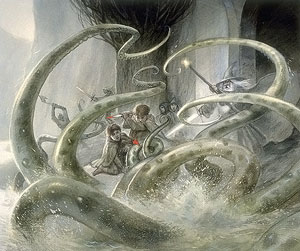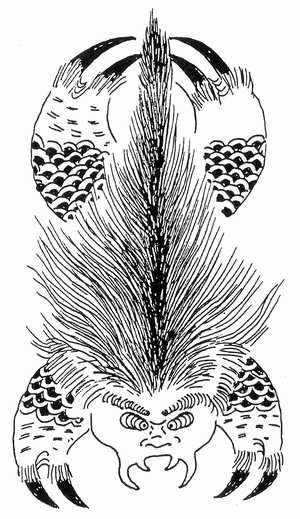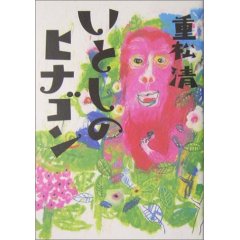Related Research Articles

The chupacabra or chupacabras is a legendary creature, or cryptid, in the folklore of parts of the Americas. The name comes from the animal's reported vampirism—the chupacabra is said to attack and drink the blood of livestock, including goats.

A dragon is a magical legendary creature that appears in the folklore of multiple cultures worldwide. Beliefs about dragons vary considerably through regions, but dragons in Western cultures since the High Middle Ages have often been depicted as winged, horned, and capable of breathing fire. Dragons in eastern cultures are usually depicted as wingless, four-legged, serpentine creatures with above-average intelligence. Commonalities between dragons' traits are often a hybridization of feline, reptilian, mammalian, and avian features. Some scholars believe large extinct or migrating crocodiles bear the closest resemblance, especially when encountered in forested or swampy areas, and are most likely the template of modern Asian dragon imagery.

The púca, pucapwca, pooka, phouka, puck is a creature of Celtic, English, and Channel Islands folklore. Considered to be bringers both of good and bad fortune, they could help or hinder rural and marine communities. Púcaí can have dark or white fur or hair. The creatures were said to be shape-changers that could take the appearance of horses, goats, cats, dogs, and hares. They may also take a human form, which includes various animal features, such as ears or a tail.

The bogeyman is a mythical creature used by adults to frighten children into good behaviour. Bogeymen have no specific appearances and conceptions vary drastically by household and culture, but they are most commonly depicted as masculine or androgynous monsters that punish children for misbehaviour. The bogeyman, and conceptually similar monsters can be found in many cultures around the world. Bogeymen may target a specific act or general misbehaviour, depending on the purpose of invoking the figure, often on the basis of a warning from an authority figure to a child. The term is sometimes used as a non-specific personification of, or metonym for, terror, and sometimes the Devil.

A balaur in Romanian folklore is a type of many-headed dragon or monstrous serpent, sometimes said to be equipped with wings. The number of heads is usually around three, but they can also have seven heads or even twelve heads according to some legends.

The Watcher in the Water is a fictional creature in J. R. R. Tolkien's Middle-earth; it appears in The Fellowship of the Ring, the first volume of The Lord of the Rings. Lurking in a lake beneath the western walls of the dwarf-realm Moria, it is said to have appeared after the damming of the river Sirannon, and its presence was first recorded by Balin's dwarf company 30 or so years before the beginning of The Fellowship of the Ring.

A practical effect is a special effect produced physically, without computer-generated imagery or other post-production techniques. In some contexts, "special effect" is used as a synonym of "practical effect", in contrast to "visual effects" which are created in post-production through photographic manipulation or computer generation.

In Japanese mythology, the raijū is a legendary creature associated with lightning and thunder, as well as the god Raijin.

In the folklore of the Alpine region of south-central Europe, the Tatzelwurm, Stollenwurm, or Stollwurm is a lizard-like creature, often described as having the face of a cat, with a serpent-like body which may be slender or stubby, with four short legs or two forelegs and no hindlegs.

The Sigbin or Sigben is a creature in Philippine mythology said to come out at night to suck the blood of victims from their shadows. It is said to walk backwards with its head lowered between its hind legs, and to have the ability to become invisible to other creatures, especially humans. It resembles a hornless goat, but has very large ears which it can clap like a pair of hands and a long, flexible tail that can be used as a whip. The Sigbin is said to emit a nauseating odor.

The Hibagon (ヒバゴン) or Hinagon (ヒナゴン) is the Japanese equivalent of the North American Bigfoot or the Himalayan Yeti. Sightings have been reported since the 1970s around Mount Hiba in the Hiroshima Prefecture.

A lutin is a type of hobgoblin in French folklore and fairy tales. Female lutins are called lutines.
Mythic humanoids are legendary, folkloric, or mythological creatures that are part human, or that resemble humans through appearance or character. Each culture has different mythical creatures that come from many different origins, and many of these creatures are humanoids. They are often able to talk and in many stories they guide the hero on their journey.

All Creatures Great and Small is a British television series made by the BBC and based on the books of the British veterinary surgeon Alf Wight, who wrote under the pseudonym James Herriot. Set in the Yorkshire Dales and beginning in the mid-1930s, it stars Christopher Timothy as Herriot, Robert Hardy as Siegfried Farnon, the proprietor of the Skeldale House surgery, and Peter Davison as Siegfried's "little brother", Tristan. Herriot's wife, Helen, was initially played by Carol Drinkwater and in the later series by Lynda Bellingham.

Frankenstein; or, The Modern Prometheus is an 1818 novel written by English author Mary Shelley. Frankenstein tells the story of Victor Frankenstein, a young scientist who creates a sapient creature in an unorthodox scientific experiment. Shelley started writing the story when she was 18, and the first edition was published anonymously in London on 1 January 1818, when she was 20. Her name first appeared in the second edition, which was published in Paris in 1821.
Qailertetang is an Inuit goddess who cares for animals, fishers, and hunters and who controls the weather. She dwells with her companion Sedna at the bottom of the sea in the company of seals, whales, and other sea creatures. Qailertetang is depicted as a "large woman of very heavy limbs". Before hunts, she, along with Sedna, are served by shamans on behalf of the rest of the tribe in rituals designed to ensure success in said hunts as coastal Inuit groups' diets mostly consist of sea animals.

Ashinaga-tenaga are a pair of yōkai in Japanese folklore. One, Ashinaga-jin (足長人), has extremely long legs, while the other, Tenaga-jin (手長人), has extremely long arms. They were first described in the Japanese encyclopedia Wakan Sansai Zue. They are said to be found in Kyūshū.

A legendary creature is a type of fantasy entity, typically a hybrid, that has not been proven and that is described in folklore, but may be featured in historical accounts before modernity.

A Quiet Place is a 2018 American post-apocalyptic science fiction horror film directed by John Krasinski and written by Scott Beck and Bryan Woods and Krasinski, from a story conceived by Woods and Beck. The plot revolves around a mother and father (Krasinski) who struggle to survive and raise their children in a post-apocalyptic world inhabited by blind extraterrestrial creatures with an acute sense of hearing.
The Karnabo is a creature of Ardennes folklore. It is reputedly the offspring of a supernatural entity and a Bohemian traveller. The Karnabo resembles a man but with an elephant's trunk for a nose and the eyes of a basilisk. The breath of the creature is said to be able to paralyse men and kill animals. It is said to have abducted a young girl and folklore states that her moans and trumpet of the creature can be heard during thunderstorms.
References
- ↑ Matthews, John & Caitlin (2005). The Element Encyclopedia of Magical Creatures. Harper Collins. p. 6. ISBN 0-00-720873-1.